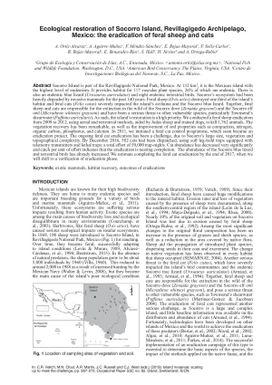Ecological restoration of Socorro Island, Revillagigedo Archipelago, Mexico: the eradication of feral sheep and cats.
- Description:
- Socorro Island is part of the Revillagigedo National Park, Mexico. At 132 km2, it is the Mexican island with the highest level of endemism. It provides habitat for 117 vascular plant species, 26% of which are endemic. There is also an endemic blue lizard (Urosaurus auriculatus) and eight endemic terrestrial birds. Socorros ecosystem had been heavily degraded by invasive mammals for the past 140 years. Feral sheep (Ovis aries) destroyed one third of the islands habitat and feral cats (Felis catus) severely impacted the islands avifauna and the Socorro blue lizard. Together, feral sheep and cats are responsible for the extinction in the wild of the Socorro dove (Zenaida graysoni) and the Socorro elf owl (Micrathene whitneyi graysoni) and have been a serious threat to other vulnerable species, particularly Townsends shearwater (Pu?nus auricularis). As such, the islands restoration is a high priority. We conducted a feral sheep eradication from 2009 to 2012, using aerial and terrestrial methods, aided by Judas sheep and trained dogs, to kill 1,762 animals. The vegetation recovery has been remarkable, as well as the improvement of soil properties such as compaction, nitrogen, organic carbon, phosphorus, and calcium. In 2011, we initiated a feral cat control programme, which soon became an eradication project. The ongoing feral cat eradication has been a challenge, due to Socorros large size, vegetation and topographical complexity. By December 2016, 502 cats had been dispatched, using soft leg-hold traps equipped with telemetry transmitters and lethal traps: a total e? ort of 50,000 trap-nights. Cat abundance has decreased very signi?cantly and catch per unit of e? ort indicates that the eradication is nearing completion. The abundance of the Socorro blue lizard and terrestrial birds has already increased. We estimate completing the feral cat eradication by the end of 2017, when we will shift to a veri?cation of eradication phase.
- Display date:
- 2019
- Collections:
- Secretariat of the Pacific Regional Environment Programme (SPREP)
- Publisher:
- International Union for Nature Conservation (IUCN)
- Content partner:
- Secretariat of the Pacific Regional Environment Programme (SPREP)
- Availability:
- Not specified
-
Copyright status: All rights reservedFind out more about what you are able to do with this itemThis item is all rights reserved, with means you'll have to get permission from Secretariat of the Pacific Regional Environment Programme (SPREP) before using it. For more information, please see our use and reuse page.What can I do with this item?Non-infringing useNZ copyright law does not prevent every use of a copyright work, and this item may be hosted by an international institute or organisation. You should consider what you can and cannot do with a copyright work.No sharingYou may not copy and/or share this item with others without further permission. This includes posting it on your blog, using it in a presentation, or any other public use.No modifyingYou are not allowed to adapt or remix this item into any other works.No commercial useYou may not use this item commercially.
Welcome and warm Pasifik greetings
The information on this site has been gathered from our content partners.
The names, terms, and labels that we present on the site may contain images or voices of deceased persons and may also reflect the bias, norms, and perspective of the period of time in which they were created. We accept that these may not be appropriate today.
If you have any concerns or questions about an item, please contact us.
